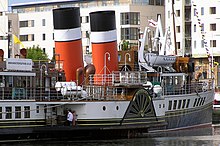
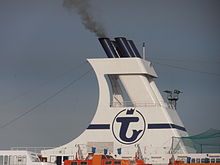
A funnel is the smokestack or chimney on a ship used to expel boiler steam and smoke or engine exhaust. They are also commonly referred to as stacks.


A funnel is the smokestack or chimney on a ship used to expel boiler steam and smoke or engine exhaust. They are also commonly referred to as stacks.
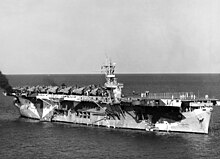
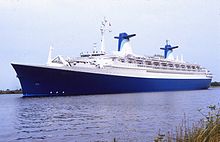
The primary purpose of a ship's funnel(s) is to lift the exhaust gases clear of the deck, in order not to foul the ship's structure or decks, and to avoid impairing the ability of the crew to carry out their duties.
In steam ships the funnels also served to help induce a convection draught through the boilers.
Since the introduction of steam-power to ships in the 19th century, the funnel has been a distinctive feature of the silhouette of a vessel, and used for recognition purposes.
The required funnel cross-sectional area is determined by the volume of exhaust gases produced by the propulsion plant. Often this area is too great for a single funnel. Early steam vessels needed multiple funnels (SS Great Eastern had 5 when launched), but as efficiency increased new machinery needed fewer funnels.
Merchant shipping companies (and particularly liner companies such as Cunard Line and ferries such as Red Funnel) were quick to recognise the publicity value of distinctive funnels, both in terms of shape, number of funnels, and the colours they were painted. In an era when ship hulls were uniformly painted black (to conceal inevitable dirt when loading the ship with coal) and superstructures were white (to control the temperature in the passenger accommodation in hot summers) the funnel was one of the few parts of the ship that a company could use to clearly differentiate its ships from those of its competitors. Each company would have their own "house colours", which were often used in publicity material as well as for recognition, making funnel colours an early form of trademark. [1] Some companies became so closely associated with their funnel colours that their nickname became a de facto company name. For example, the shipping line actually registered as 'Alfred Holt & Company' was more widely known as the Blue Funnel Line. The Southampton, Isle of Wight and South of England Royal Mail Steam Packet Company has traded under the name Red Funnel for most of its 150+ year history. Other colours such as the red with black stripes of the Cunard Line and the all buff colour of P&O remain icons of their respective lines and have remained in use for over a century through many changes of corporate ownership.

Sometimes the shape of the funnel is used as distinguishing feature rather than just the colour. Cunard fitted ships of its Saxonia class with streamlined round tops to the funnels. Intended as an aerodynamic aid to keep exhaust clear of the deck the modification had very little practical effect but was retained because it made the four ships of the class immediately recognisable and gave Cunard a suitable modern image. There was a trend for 'designer funnels' on liners in the 1960s as fashion and aerodynamic advances combined to offer designers more options that the traditional cylindrical smokestack. The Italian Line fitted the liners Michelangelo and Raffaello with funnels topped by flat discs supported on exposed diagonal bracing while P&O's Oriana and Canberra had tall, thin funnels with aerofoil cross sections.
In the late 19th and the first half of the 20th century the number of funnels became associated with speed and reliability. For this reason a number of the great liners carried additional false funnels that they did not need.[ citation needed ] Examples included the White Star Line's RMS Titanic, Hamburg America Line's SS Imperator, and later the French Line's SS Normandie. In most cases there was only a single false funnel placed as the aftermost of the funnels. The false funnels did have more uses than simply aiding aesthetics however - a stoker who survived the sinking of the Titanic escaped the boiler room by ascending the false funnel, the aft funnel of Normandie housed the passengers' dog kennels, and Disney Cruise Line's Disney Magic's forward funnel plays host to a teens-only club.
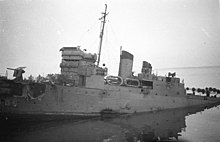

A key part of the deception practiced by ships carrying out commerce raiding during both the First World War and Second World War was to disguise their ship's outline, and this included using false funnels or by changing the height or diameter of the actual funnel(s). [2]
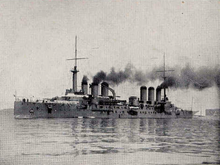
Four naval ships with six funnels each were constructed in the late 19th and early 20th centuries: two Italia-class ironclad battleships operated by the Italian Navy from 1885 to 1921, and two Edgar Quinet-class armored cruisers operated by the French Navy from 1911 to 1932. Both had their funnels in two groups of three before and abaft of center.
A mack is a combined stack and mast, as fitted to some classes of 20th century warships. Although they can reduce top-weight, they have not gained universal popularity due to the problem of exhaust gases corroding electrical aerials and equipment.
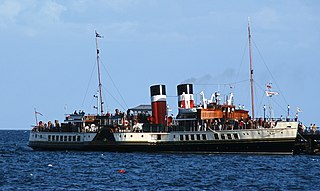
A steamship, often referred to as a steamer, is a type of steam-powered vessel, typically ocean-faring and seaworthy, that is propelled by one or more steam engines that typically move (turn) propellers or paddlewheels. The first steamships came into practical usage during the early 1800s; however, there were exceptions that came before. Steamships usually use the prefix designations of "PS" for paddle steamer or "SS" for screw steamer. As paddle steamers became less common, "SS" is incorrectly assumed by many to stand for "steamship". Ships powered by internal combustion engines use a prefix such as "MV" for motor vessel, so it is not correct to use "SS" for most modern vessels.

RMS Queen Elizabeth was an ocean liner operated by Cunard Line. In tandem with Queen Mary both ships provided a weekly luxury liner service between Southampton in the United Kingdom and New York City in the United States, via Cherbourg in France.

An ocean liner is a type of passenger ship primarily used for transportation across seas or oceans. Ocean liners may also carry cargo or mail, and may sometimes be used for other purposes. Only one ocean liner remains in service today.

RMS Aquitania was an ocean liner of the Cunard Line in service from 1914 to 1950. She was designed by Leonard Peskett and built by John Brown & Company in Clydebank, Scotland. She was launched on 21 April 1913 and sailed on her maiden voyage from Liverpool to New York on 30 May 1914. She was given the title of Royal Mail Ship (RMS) like many other Cunard ocean liners since she carried the royal mail on many of her voyages. Aquitania was the third in Cunard Line's grand trio of express liners, preceded by RMS Mauretania and RMS Lusitania, and was the last surviving four-funnelled ocean liner. Shortly after Aquitania entered service, the First World War broke out, during which she was first converted into an auxiliary cruiser before being used as a troop transport and a hospital ship, notably as part of the Dardanelles Campaign.

SS Oceanic was the White Star Line's first liner and first member of the Oceanic-class; she was an important turning point in passenger liner design. Entering service in 1871 for Atlantic crossings, she was later chartered to Occidental and Oriental Steamship Company (O&O) in 1875. The ship provided passenger service for O&O in the Pacific until 1895 when she was sold for scrap.

RMS Mauretania was a British ocean liner designed by Leonard Peskett and built by Wigham Richardson and Swan Hunter on the River Tyne, England for the Cunard Line, launched on the afternoon of 20 September 1906. She was the world's largest ship until the launch of RMS Olympic in 1910. Mauretania captured the eastbound Blue Riband on the maiden return voyage in December 1907, then claimed the westbound Blue Riband for the fastest transatlantic crossing during her 1909 season. She held both speed records for 20 years.
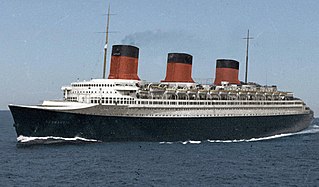
SS Normandie was a French ocean liner built in Saint-Nazaire, France, for the French Line Compagnie Générale Transatlantique (CGT). She entered service in 1935 as the largest and fastest passenger ship afloat, crossing the Atlantic in a record 4.14 days, and remains the most powerful steam turbo-electric-propelled passenger ship ever built.

Oceanic was the planned name of an unfinished ocean liner that was partially built by Harland and Wolff for the White Star Line. It would have been the third ship bearing the name Oceanic, after the one of 1870 and the one of 1899. It was envisaged in 1926, with the idea of modernizing the transatlantic service of the company. With the arrival of Lord Kylsant at the head of the company, the planned size of the project increased, until it became that of a large ship destined to be the first to exceed the symbolic limit of 1,000 feet (305 m) in length and 30 knots in speed.

RMS Majestic was a British Ocean liner working on the White Star Line’s North Atlantic run, originally launched in 1914 as the Hamburg America Liner SS Bismarck. At 56,551 gross register tons, she was the largest ship ever operated by the White Star Line under its own flag and the largest ship in the world until completion of SS Normandie in 1935.

SS France was a French transatlantic liner that sailed for the Compagnie Générale Transatlantique (CGT), known as "French Line". She was later nicknamed "Versailles of the Atlantic", a reference to her décor which reflected the famous palace outside Paris. Ordered in 1908, she was introduced into the Transatlantic route in April 1912, just a week after the sinking of RMS Titanic, and was the only French liner among the famous four-funnel liners. France quickly became one of the most popular ships in the Atlantic. Serving as a hospital ship during World War I, France would have a career spanning two decades. Her overall success encouraged CGT to create even larger liners in the future.

SS Adriatic was the first of two White Star Line ocean liners to carry the name Adriatic. The White Star Line's first four steamships of the Oceanic-class, the met with great success in the trans-Atlantic market, and the line decided to build two more. The first of these was the SS Adriatic, which was built by Harland and Wolff and launched on 17 October 1871; the second was the SS Celtic.

SS Servia, also known as RMS Servia, was a successful transatlantic passenger and mail steamer of revolutionary design, built by J & G Thomson of Clydebank and launched in 1881. She was the first large ocean liner to be built of steel instead of iron, and the first Cunard ship to have an electric lighting installation.

RMS Campania was a British ocean liner owned by the Cunard Line, built by Fairfield Shipbuilding and Engineering Company of Govan, Scotland, and launched on Thursday, 8 September 1892.

RMS Lucania was a British ocean liner owned by the Cunard Steamship Line Shipping Company, built by Fairfield Shipbuilding and Engineering Company of Govan, Scotland, and launched on Thursday, 2 February 1893.

The Olympic-class ocean liners were a trio of British ocean liners built by the Harland & Wolff shipyard for the White Star Line during the early 20th century. They were Olympic (1911), Titanic (1912) and Britannic (1914). All three were designed to be the largest and most luxurious passenger ships at that time, designed to give White Star an advantage in the transatlantic passenger trade.
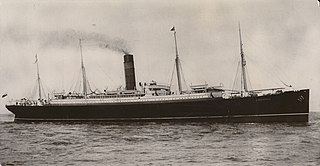
RMS Carpathia was a Cunard Line transatlantic passenger steamship built by Swan Hunter & Wigham Richardson in their shipyard in Wallsend, England.

SS Ionic was a steam-powered ocean liner built in 1902 by Harland and Wolff in Belfast for the White Star Line. She was the second White Star Liner to be named Ionic and served on the United Kingdom – New Zealand route. Her sister ships were SS Athenic and SS Corinthic.

A four-funnel liner, also known as a four-stacker, is an ocean liner with four funnels.

SS Columbia is a representation of a passenger ship in the Japanese theme park Tokyo DisneySea. It is located in the 'New York Harbor' section of the American Waterfront in the park. The ship was designed as a recreation of a 20th-century steam-powered ocean liner.

The Oceanic class were a group of six ocean liners built by Harland and Wolff at Belfast, for the White Star Line, for the transatlantic service. They were the company's first generation of steamships to serve the North Atlantic passenger trade, entering service between 1871 and 1872.
{{cite web}}: More than one of |archivedate= and |archive-date= specified (help); More than one of |archiveurl= and |archive-url= specified (help)